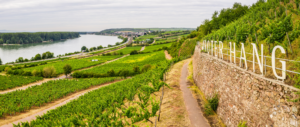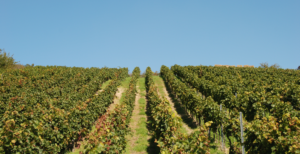A promise for the best white wines
Riesling accounts for 19.4% of the vineyards in Rheinhessen. The first references to Riesling in Rheinhessen date back more than 500 years. With 5,304 hectares, it is the most important grape variety – and the number just keeps rising.

A Riesling hotspot: The Roter Hang in Nierstein
Credit: Dominik Ketz / Rheinhessen-Touristik GmbH
Riesling matures slowly: To form the typical aromas, the grapes must remain on the vine for a long time. Under the relatively cool climatic conditions at the 50th parallel, they can develop their fine fruit aromas. In the late autumn sun, the grapes complete the ripening process and develop their fresh acidity. Riesling can excellently interpret the peculiarities of the soil on which it grows.
The Riesling from the Rote Hang vineyard between Nierstein and Nackenheim is world-famous – it is the Riesling hotspot on the Rhine terrace. Worms scores with the renowned Riesling site Liebfrauenstift-Kirchenstück. On the steep Scharlachberg in Bingen, fascinating Rieslings grow on Rheinhessen’s only quartzite deposit. The Wonnegau and the hill country have excellent Riesling sites on limestone soils such as in Westhofen (Morstein, Kirchspiel), Flörsheim-Dalsheim (Hubacker), Saulheim (Hölle) or in Appenheim (Hundertgulden). There is more: on the border to the Nahe on porphyry in Siefersheim (Heerkretz) or on the marl soils in the Selz Valley (Hahnheimer Knopf, Stadecker Spitzberg).
A miracle
Rheinhessen has a lot to offer for Burgundy lovers: noir, blanc or gris – the choice is yours! Burgundies are making a big impact and are on the rise. Which comes as no surprise: they love the soils in Rheinhessen with their formative limestone content, warmth and depth.
Thus, Rheinhessen has the best conditions for producing stylistically exciting Pinot Noir, Pinot Blanc or Pinot Gris from this illustrious family of grape varieties. This also includes the blue chips from the second row with Auxerrois, St. Laurent, Frühburgunder or Pinot Meunier (Schwarzriesling). Not to forget the rosé variants such as the Blancs de Noirs. The striking exclamation point, however, are the Pinot sparkling wines. They are the most sensual expression of what this illustrious family of grapes has up its sleeve.
Observers of the scene call the development of recent years a “Burgundy miracle”. At the beginning of the 1990s, just 4% of the total vineyard area in Rheinhessen was planted with Burgundy varieties. But the Pinot family has grown magnificently in the last 20 years. It now occupies more than 23% of the vineyards with 6,500 hectares.
Challenging but rewarding
The Silvaner has been in Germany for over 350 years. It also shares a long tradition with Rheinhessen. About 100 years ago, the Silvaner made up almost two thirds of the Rheinhessen vineyards. Even in the early 1960s, every second vine was a Silvaner. These days are gone but 1,930 hectares – that is 9.6 million vines – of Silvaner still remain.

No precipitation and lots of sun: The Silvaner can handle a lot
Credit: Martin Beckenbach
One challenge in dealing with this vine is that it is not easy to grow. It is demanding in the vineyard and needs great sensitivity in the cellar. As the saying goes: the Silvaner forgives nothing.
Yet, the Silvaner is considered a winner of climate change. Especially in vintages in which nature presents the vines with great challenges, it demonstrates its strengths. Take the 2020 vintage for example: despite low rainfall, the Silvaner produced pointed aromas and a successful balance of fruit and acidity.
It is therefore not surprising that Silvaner goes wonderfully with fine cuisine. The gastronomy has already started to rediscover it – and not just in Germany!